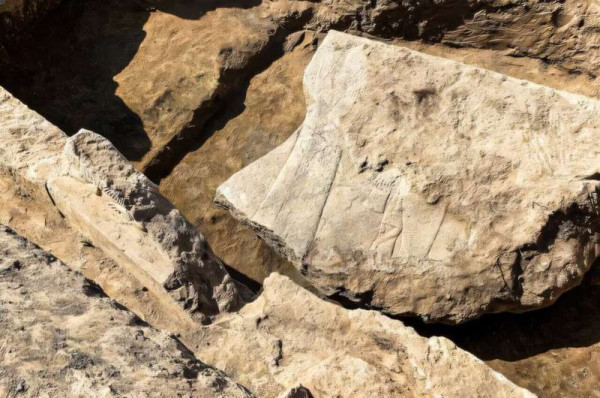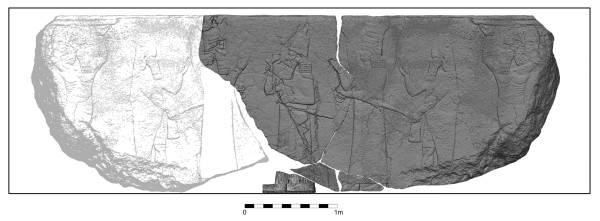
Fragment of the discovered relief. Credit: Aaron Schmitt
Ishtartv.com –phys.org
by Marietta Fuhrmann-Koch, Heidelberg University
May 13, 2025
A team from Heidelberg University excavating in Iraq made a spectacular
find: In the throne room of the North Palace of King Ashurbanipal in the
ancient city of Nineveh, the archaeologists discovered large portions of a
monumental relief that depicts the ruler of the Assyrian empire from the
seventh century BC along with two important deities and other figures.
The relief was carved on a massive stone slab 5.5 meters long and 3
meters high and weighing approximately 12 tons. The find is extraordinary for
the researchers not only for its size, but also for the scenes depicted.
"Among the many relief images of Assyrian palaces we know of, there
are no depictions of major deities," states the head of the excavations in
the North Palace, Prof. Dr. Aaron Schmitt of the Institute of Prehistory,
Protohistory and Ancient Near Eastern Archaeology.
The ancient city of Nineveh, located near the modern Iraqi city of
Mosul, is considered to be one of the most important cities of North
Mesopotamia and, under King Sennacherib, became the capital of the Assyrian
empire in the late eighth century BC. Since 2022, Aaron Schmitt and his team
have been investigating the Kuyunjik mound in the core sector of the North
Palace built by King Ashurbanipal.
The excavations are conducted as part of the Heidelberg Nineveh project
begun in 2018 under the direction of Prof. Dr. Stefan Maul of the Department of
Languages and Cultures of the Near East at Heidelberg University. At the end of
the 19th century, British researchers first explored the North Palace of
ancient Nineveh and discovered large-scale reliefs, which are now on exhibit in
London's British Museum.
Shown in the center of the recently discovered relief is King
Ashurbanipal, the last great ruler of the Assyrian empire. He is flanked by two
supreme deities: the gods Ashur and Ishtar, patron goddess of Nineveh. They are
both followed by a fish genius, who grants the gods and the sovereign salvation
and life, as well as a supporting figure with arms raised, most likely to be
restored as a scorpion-man.
"These figures suggest that a massive winged sun disk was
originally mounted above the relief," explains Prof. Schmitt. Over the
coming months, based on the data collected on site, the researchers will
investigate the depiction in detail as well as the find context and publish the
results in a scientific journal.
According to Prof. Schmitt, the relief was originally located in a niche
across from the main entrance to the throne room, i.e., the most important
place in the palace. The Heidelberg researchers discovered the relief
fragments in an earth-filled pit behind this niche. It was probably dug in the
Hellenistic period in the third or second century before Christ.
"The fact that these fragments were buried is surely one reason why
the British archaeologists never found them over a hundred years ago,"
assumes Prof. Schmitt. As agreed with the Iraqi State Board of Antiquities and
Heritage (SBAH), the medium-term plan is to place the relief on its original
site and open it to the public.

3D model of the relief: The finds are marked in dark gray, the light gray part represents a reconstruction based on the finds. King Ashurbanipal is depicted in the center. Credit: Heidelberg University
|